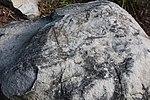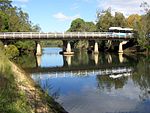Fiddens Wharf
Convicts transported to AustraliaForests of New South WalesHistory of SydneyKillara, New South WalesLane Cove River ... and 2 more
Use Australian English from June 2018Wharves in Australia

Fiddens Wharf or Killara Wharf was a former wharf on the Lane Cove River in Sydney, Australia. Named after the convict Joseph Fidden, the wharf was primarily used for the transport of timber and supplies to and from Sydney in the 19th century. It is unknown whether the original structure was a conventional wharf, or a mooring place with lines connected to a metal ring secured in a nearby rock. Fiddens was one of the three main wharves on the river.
Excerpt from the Wikipedia article Fiddens Wharf (License: CC BY-SA 3.0, Authors, Images).Fiddens Wharf
The Great North Walk, Sydney Lindfield
Geographical coordinates (GPS) Address Nearby Places Show on map
Geographical coordinates (GPS)
| Latitude | Longitude |
|---|---|
| N -33.783283 ° | E 151.144643 ° |
Address
The Great North Walk
The Great North Walk
2070 Sydney, Lindfield
New South Wales, Australia
Open on Google Maps




